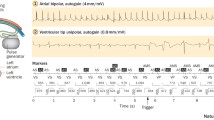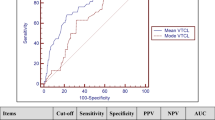Abstract
Aim of the study: The Consistent Atrial Pacing (CAP) algorithm has been designed to achieve a high percentage of atrial pacing to suppress paroxysmal atrial fibrillation. The aim of our study was to compare the impact of DDDR+CAP versus DDDR pacing on paroxysmal atrial fibrillation recurrences and triggers in patients with Brady-Tachy Syndrome.
Methods: 61 patients, 23 M and 38 F, mean age 75±9 y, affected by Brady-Tachy Syndrome, implanted with a DDDR pacemaker, were randomized to DDDR or DDDR+CAP pacing with cross over of pacing modality after 1 month.
Results: 78 % of patients in DDDR pacing and 73 % in DDDR+CAP pacing (p=n.s.) were free from symptomatic paroxysmal atrial fibrillation recurrences. During DDDR+CAP pacing, the atrial pacing percentage increased from 77±29 % to 96±7 % (p<0.0001). Automatic mode switch episodes/day were 0.73±1.09 in DDDR and 0.79±1.14 (p=n.s.) in DDDR+CAP. In patients with less than 50 % of atrial pacing during DDDR, automaticmode switch episodes/day decreased during DDDR+CAP from 1.13±1.59 to 0.23±0.32 (p<0.05) and in patients with less than 90 % from 1.23±1.27 to 0.75±1.10 (p<0.001). The number of premature atrial complexes per day decreased during DDDR+CAP from 2665±4468 to 556±704 (p<0.02).
Conclusion: CAP algorithm allowed continuous overdrive atrial pacing without major side effects. Triggers of paroxysmal atrial fibrillation induction, such as premature atrial complexes, were critically decreased. Paroxysmal atrial fibrillation episodes were reduced in patients with atrial pacing percentage lower than 90 % during DDDR pacing.
Similar content being viewed by others
References
Barold SS, Santini M. Natural history of sick sinus syndrome after pacemaker implantation. In: Barold SS, Mugica J, eds. New Perspective in Cardiac Pacing 3. New York: Futura Publishing Co., Mt Kisco, 1993:169-211.
Santini M, Ricci R, Puglisi A, et al. Long-term haemodynamic and antiarrhythmic benefits of DDIR versus DDI pacing mode in sick sinus syndrome and chronotropic incompetence. G Ital Cardiol1997;27:892-900.
Rosenqvist M, Brandt J, Schuller H. Long-term pacing in sinus node disease: effects of stimulation mode on cardiovascular morbidity and mortality. Am Heart J1988;116:16-22.
Spencer WH, Markowitz T, Alagona P. Rate augmentation and atrial arrhythmias in DDDR pacing. PACE1990;13(II):1847-1851.
Feuer JM, Shandling AH, Messenger JC. Influence of cardiac pacing mode on the long-term development of atrial fibrillation. Am J Cardiol1989;64:1376-1379.
Andersen HR, Nielsen JC, Thomsen PEB, et al. Longterm follow up of patients from a randomised trial of atrial versus ventricular pacing for sick-sinus syndrome. Lancet1997;350:1210-1216.
Skanes AC, Krahn AD, Yee R, et al. Physiologic pacing reduces progression to chronic atrial fibrillation. PACE1999;22:728. (abstract)
Josephson ME, Schibgilla VH. Non-pharmacological treatment of supraventricular arrhythmias. Eur Heart J1996;17:26-34.
Zhu DW, Spencer WH. Electrophysiology, pacing and arrhythmia. Clin Cardiol1996;19:737-742.
Fahy GJ, Wilkoff BL. Pacing strategies to prevent atrial fibrillation. Cardiol Clin1996;14:591-596.
Schoels W, Becker R. Mechanisms of pacing interventions in atrial fibrillation. J Cardiovasc Electrophysiol1998;9(suppl. 8):S13-S17.
Slade AKB, Camm J. Pacing to prevent atrial fibrillation. In: Oto AM, ed. Practice and Progress in Cardiac Pacing and Electrophysiology. Netherlands: Kluwer Academic Publishers, 1996:175-187.
Page PL. Sinus node during atrial fibrillation. To beat or not to beat? Circulation1992;86:334-336.
Kirchhof CJ, Allessie MA. Sinus node automaticity during atrial fibrillation in isolated rabbit hearts. Circulation1992;86:263-271.
Ramdat Misier AR, Beukema WP, Oude Luttikhuis HA. Multisite or alternate site pacing for the prevention of atrial fibrillation. Am J Cardiol1999;83:237D-240D.
Ricci R, Azzolini P, Puglisi A, et al. Consistent atrial pacing: can this new algorithm suppress recurrent paroxysmal atrial fibrillation? G Ital Cardiol1998;28(suppl. 1):115-118.
Bubien RS, Kay GN, Jenkins LS. Test specifications for symptom checklist: frequency and severity. 1993, University of Winsconsin-Milwaukee, Milwaukee.
Ricci R, Puglisi A, Azzolini P, et al. Reliability of a new algorithm for automatic mode switching from DDDR to DDIR pacing mode in sinus node disease patients with chronotropic incompetence and recurrent paroxysmal atrial fibrillation. PACE1996;19:1719-1723.
Sutton R, Kenny RA. The natural history of sick sinus syndrome. PACE1986;9:1110-1114.
Camm AJ, Katritsis D. Ventricular pacing for sick sinus syndrome: a risky business? PACE1990;13:695-699.
Santini M, Alexidou G, Ansalone G, Cacciatore G, Cini R, Turitto G. Relation of prognosis in sick sinus syndrome to age, conduction defects and modes of permanent cardiac pacing. Am J Cardiol1990;65:729-735.
Stangl K, Seitz K, Wirtzfeld A, Alt E, Blommer H. Differences between atrial single chamber pacing (AAI) and ventricular single chamber pacing (VVI) with respect to prognosis and antiarrhythmic effect in patients with sick sinus syndrome. PACE1990;13:2080-2085.
Hesselson AB, Parsonnet V, Bernstein AD, Bonavita GJ. Deleterious effects of long-term single-chamber ventricular pacing in patients with sick sinus syndrome: the hidden benefits of dual-chamber pacing. J Am Coll Cardiol1992;19:1542-1549.
Sgarbossa EB, Pinski SL, Maloney JD, et al. Chronic atrial fibrillation and stroke in paced patients with sick sinus syndrome. Relevance of clinical characteristics and pacing modalities. Circulation1993;88:1045-1053.
Boriani G, Botto GL, Frabetti L, et al. Does dual chamber pacing prevent paroxysmal atrial fibrillation in brady-tachy patients? G Ital Cardiol1998;28 (suppl. 1):121-124.
Bellocci F, Spampinato A, Ricci R, et al. Antiarrhythmic benefits of dual chamber stimulation with rateresponse in patients with paroxysmal atrial fibrillation and chronotropic incompetence. A prospective multicentre study. Europace1999;1:220-225.
Sutton R. Is rate response superior to single rate pacing in atrial arrhythmia control? Europace1999;1:211-212.
Garrigue S, Barold S, Cazeau S, et al. Prevention of atrial arrhythmias during DDD pacing by atrial overdrive. PACE1998;21:1751-1759.
Levy T, Walker S, Rochelle J, Paul V. Evaluation of biatrial pacing, right atrial pacing, and no pacing in patients with drug refractory atrial fibrillation. Am J Cardiol1999;84:426-429.
Funck RC, Capucci A, Kappenberger L, et al. Prevention of atrial arrhythmias by overdriving and the rest rate: preliminary results from the PROVE study (abs). Eur Heart J1999;20(abs. suppl.)(155):5.
Saksena S, Prakash A, Hill M, et al. Prevention of recurrent atrial fibrillation with chronic dual-site right atrial pacing. J Am Coll Cardiol1996;28:687-694.
Delfaut P, Saksena S, Prakash A, Krol RB. Long-term outcome of patients with drug-refractory atrial flutter and fibrillation after single and dual-site right atrial pacing for arrhythmia prevention. J Am Coll Cardiol1998;32:1900-1908.
Ward KJ, Kamalvand K, Sulke N, et al. Failure of different rates of right atrial appendage pacing to suppress episodes of paroxysmal atrial fibrillation. J Am Coll Cardiol1999;33:1173-155. (abstract)
Murgatroyd FD, Nitzsché R, Slade AKB, et al. A new pacing algorithm for overdrive suppression of atrial fibrillation. PACE1994;17(II):1966-1973.
Ricci R, Puglisi A, Peraldo Neja C, et al. Consistent atrial pacing: can this new algorithm suppress recurrent paroxysmal atrial fibrillation? PACE1997;20:1227. (abstract)
Capucci A, Villani G, Groppi F, et al. DDD versus DDDR to prevent PAF in elderly: a randomized study. PACE1997;20:1228. (abstract)
Hnatkova K, Murgatroyd FD, Guo X, Camm AJ, Malik M. Atrial premature beats preceding episodes of paroxysmal atrial fibrillation: factorial analysis of a prediction system. PACE1997;20:2003-2007.
Andersen HD, Nielsen JC. Pacing in sick sinus syndrome. Need for a prospective, randomized trial comparing atrial with dual chamber pacing. PACE1998;21:1175-1179.
Daubert JC, Mabo P, Berder V, Gras D. Atrial flutter and interatrial conduction block: preventive role of biatrial synchronous pacing. In: Waldo AL, Toubul P, eds. Atrial Flutter: Advances in Mechanisms and Management. Armonk, NY: Futura Publ. Co. Inc., 1996:331-346.
Padeletti L, Porciani MC, Michelucci A, et al. Interatrial septum pacing: a new approach to prevent recurrent atrial fibrillation. J Interv Electrophysiol1999;3:35-43.
Author information
Authors and Affiliations
Rights and permissions
About this article
Cite this article
Ricci, R., Santini, M., Puglisi, A. et al. Impact of Consistent Atrial Pacing Algorithm on Premature Atrial Complexe Number and Paroxysmal Atrial Fibrillation Recurrences in Brady-Tachy Syndrome: A Randomized Prospective Cross Over Study. J Interv Card Electrophysiol 5, 33–44 (2001). https://doi.org/10.1023/A:1009801706928
Published:
Issue Date:
DOI: https://doi.org/10.1023/A:1009801706928




